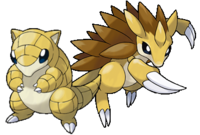On the Origin of Species: Sandshrew and Sandslash
|
Two of the more curious designs in Generation I belong to Sandshrew and its evolution, Sandslash. The Pokédex identifies their species as 'Mouse Pokémon', but like quite a lot of the species names (Blastoise is a shellfish? Wooper is a fish? Slowbro is a hermit crab?) this isn't all that accurate or informative. Though they both have something of a rodent-like appearance, the real-life species that inspired this family is from an entirely different group of mammals.
Meet the pangolin: an animal that takes its personal protection very seriously. There are eight known species of these armored oddities, found mostly in the tropical regions of Asia and Africa. While they certainly aren't rodents, there isn't yet a complete consensus on what their closest relatives might be: until recently they were grouped within the order Xenarthra, home to the anteaters, armadillos and sloths. Genetically, though, they seem to have more in common with the carnivores, and at the moment most scientists place them in their very own order of mammals, the Pholidota.
The most noticeable thing about the pangolin is that it barely looks like a mammal at all. One zoologist memorably describes the species as looking a walking artichoke. It's the only mammal to have scales, giving it a superficially reptilian appearance. Just like reptilian scales, they are made from a tough protein called keratin, which is also found in hair, claws and nails. The scales are attached to the body like overlapping plates, and are soft when a pangolin is born, but fully harden within a few days. These scales represent the pangolin's main form of defense, and they are often sharp enough to inflict nasty injuries upon would-be predators. When threatened, a pangolin simply curls up into a ball, its whole body protected by its armor-like plating. This plating can even be shifted back and forth by attached muscles, producing a cutting motion likely to put off even the hungriest of foes. A mother can curl up around her young to protect them in a similar manner. The name 'pangolin' actually comes from the Malay word pengguling, which means 'something that rolls up'. As if these defenses weren't enough, pangolins can even emit a foul scent when threatened, in much the same way that skunks do.
The pangolin is often referred to as the scaly anteater. Though pangolins and anteaters are not now thought to be closely related, they do have many traits in common, most notably their diet and method of feeding. Most pangolin species use their powerful front claws to tear open the nests of ants and termites, just as giant anteaters do. These claws are so long that the pangolin must walk on its knuckles, the claws tucked underneath the body. Both pangolins and anteaters also possess unusually long tongues, able to pick up insects on their sticky surface. The pangolin's tongue is so long that it is sheathed in the chest cavity, and is anchored to the pelvic bone! Small insects make up the diet of every pangolin species, and they are so thoroughly adapted to this diet that they don't even have teeth, or the ability to chew. Instead, they ingest stones and gravel, which remain in the stomach and aid in grinding up their food.
Another remarkable feature of the pangolin is its tail. In some cases, the tail makes up two thirds of the body length, and certain species, such as the tree pangolin (Manis tricuspis), are able to use their tails to hang from tree branches while they strip away bark with their front claws, in search of insects. The long tail also acts as a useful counterweight, enabling them to walk on their hind legs if necessary.
Though Sandshrew and Sandslash are obviously Ground-types, and their Pokédex entries describe them as favoring deserts, pangolins are quite varied in their preferred habitats, and are found across Africa and Asia in environments ranging from forests to savannas. Many species do live in burrows and favor sandy soil, much like their Pokémon counterparts, but pangolins don't share Sandshrew's aversion to water: some species are actually accomplished swimmers, and can fill their stomachs with air to increase their buoyancy.
It's worth mentioning that many fans associate Sandshrew and Sandslash with armadillos, and it's not too difficult to see why. They have a similar appearance to pangolins, similar habits, and are more commonly known to Western players due to their presence in the Americas. The armadillo's armor, however, comprises a bony 'shell' rather than individual plates, and such plates are a key element in the designs of these Pokémon, being especially obvious in Sandslash. Further proof of the relationship can be found in Sandslash's Japanese name, Sandpan (サンドパン), which incorporates the 'pan' of 'pangolin'.
I've often wondered why the pangolin isn't a more widely-known creature. It has so many fascinating quirks, and is so undeniably cute that it seems as if it should be more popular. Perhaps their obscurity is partly a result of the difficulties inherent in keeping them in captivity: they tend not to thrive in zoos, and so the average person is unlikely to encounter one. Breeding studies are ongoing, however, and may become increasingly necessary. Sadly, pangolins in the wild are threatened both by habitat loss and hunting, so an enhanced understanding of their ways may ultimately prove vital in protecting these unashamedly odd mammals.

